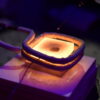An international team of researchers has found evidence of the mineral jarosite in ice cores extracted from Antarctica. In their paper published in the journal Nature Communications, the researchers describe how the discovery came about and why they believe it could bolster theories regarding the presence of the same mineral on the surface of Mars.
Jarosite is very rarely found on Earth—it is generally seen in mining waste that has been exposed to air and rain. The researchers with this new effort were not looking for it in their ice cores—they were focused on minerals in deep ice cores that might help to better understand ice age cycles. But when they came across the yellow-brown mineral, their interest was piqued. X-ray absorption testing and electron microscopy showed it be jarosite.
The researchers suggest the mineral formed in ice pockets that also held small amounts of dust. Under the ice, they had eroded, the researchers noted. The finding brought to mind another site where jarosite is found—the surface of Mars. It was found there by the Opportunity rover back in 2004 and has been found to be abundant. Finding jarosite on Mars created a lot of excitement at NASA and around the world, because prior research had shown that water must be present for jarosite formation.
The discovery of jarosite on Mars led scientists to come up with theories to explain how it might have originated. Some suggested it might have been left behind as salty water evaporated. Others suggested that Mars might have been covered by a massive ice blanket billons of years ago. They further suggested that jarosite could have formed in ice pockets. That would have been possible, they noted, if the ice blanket grew slowly with dust blowing onto it. At the time the theory was formulated, it was difficult to test because it had never been found to form that way anywhere else, including Earth.
Now that jarosite has been found deep in Antarctic ice, the latter theory will likely become the most prominent. The researchers note that the theory still has one glitch—the ice in Antarctica contains very small amounts of jarosite—on Mars, the mineral is found in large slabs. The researchers suggest that the difference might be explained by the huge amounts of dust on the Martian surface.
Image: Jarosite in the Noctis Labyrinthus Region of Mars
More information:
Giovanni Baccolo et al. Jarosite formation in deep Antarctic ice provides a window into acidic, water-limited weathering on Mars, Nature Communications (2021). DOI: 10.1038/s41467-020-20705-z
2021 Science X Network
Citation:
Mineral often found on Mars discovered deep in Antarctic ice (2021, January 29)
retrieved 30 January 2021
from https://phys.org/news/2021-01-mineral-mars-deep-antarctic-ice.html
This document is subject to copyright. Apart from any fair dealing for the purpose of private study or research, no
part may be reproduced without the written permission. The content is provided for information purposes only.



